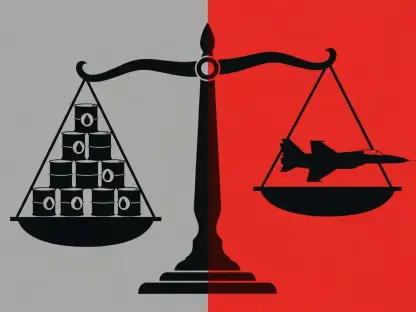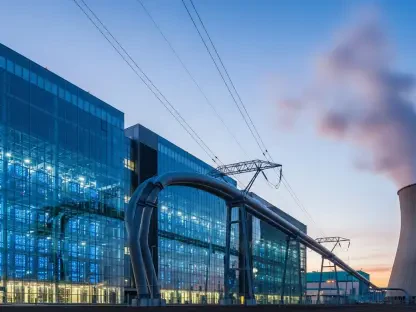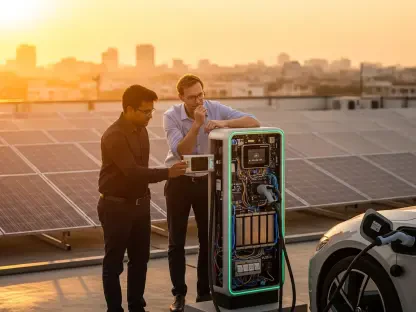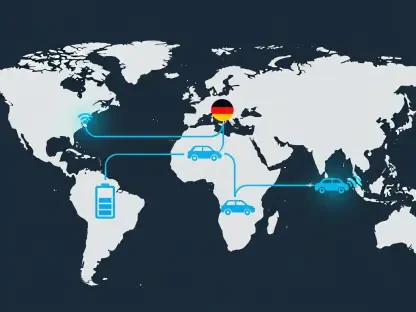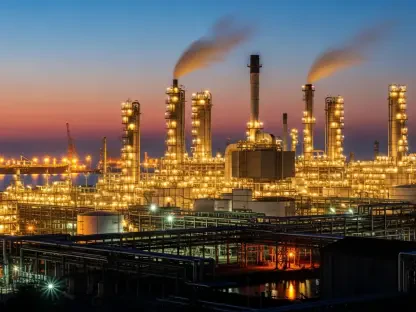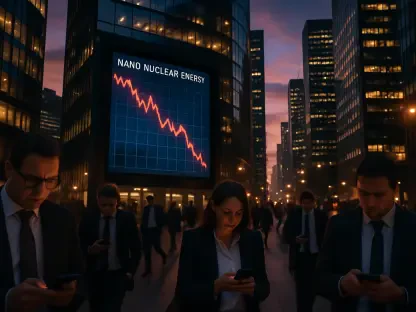The energy sector in the United States finds itself at a pivotal moment, wrestling with unprecedented power demands and persistent grid instability while navigating a complex and often unsupportive federal policy environment following the passage of the “One Big Beautiful Bill.” This landmark legislation has seemingly shifted national priorities away from energy initiatives, leaving a void that states and private developers must fill. Amid rising challenges like the exponential growth of AI-driven data centers and the intensifying impacts of climate change, the industry is turning to innovative solutions such as distributed energy resources (DERs) and microgrids to ensure reliability and sustainability. This exploration delves into how localized actions and cutting-edge technologies, particularly predictive DER modeling, are driving momentum in energy projects despite federal setbacks. The urgency to adapt to modern needs has never been clearer, as the balance between consumption, environmental stressors, and policy constraints shapes the path forward for a resilient energy future.
Confronting Modern Energy Hurdles
The energy landscape is under immense strain from escalating power demands and recurring grid instability, issues that have become increasingly evident in recent years. Data centers, propelled by advancements in artificial intelligence, have reported a staggering 12% annual increase in electricity consumption over the past half-decade, placing enormous pressure on existing infrastructure. Compounding this, a striking 80% of major power outages across the U.S. between 2000 and 2023 were attributed to weather-related events, highlighting the vulnerability of traditional grids to environmental disruptions. These dual forces—technological growth and climate unpredictability—expose the limitations of outdated systems, making it imperative to seek alternative approaches. The need for innovation is not just a response to current failures but a proactive step to safeguard against future crises, ensuring that energy supply can keep pace with societal and industrial evolution.
Beyond the raw numbers, the implications of these challenges ripple through communities and economies, often leaving businesses and households in the dark during critical moments. Grid instability disrupts daily life, halts operations, and incurs significant financial losses, particularly when extreme weather events strike with little warning. The growing reliance on digital infrastructure, fueled by AI and other tech advancements, means that even brief outages can have outsized consequences, from stalled transactions to compromised data security. Meanwhile, the environmental toll of maintaining an overtaxed grid often leads to higher emissions as backup systems, frequently reliant on fossil fuels, kick into gear. Addressing these intertwined issues requires a fundamental rethinking of how energy is produced, distributed, and managed—a shift that moves away from centralized, vulnerable systems toward more adaptive and resilient frameworks.
Harnessing the Power of Microgrids and DERs
Microgrids and distributed energy resources (DERs) are emerging as vital tools in the quest for a more stable and sustainable energy ecosystem, offering a way to circumvent the shortcomings of traditional grids. These systems, which can operate independently or in tandem with the central grid, provide a critical safety net during outages triggered by severe weather or demand surges. Their ability to isolate and sustain power locally ensures continuity for hospitals, businesses, and residential areas when larger networks fail. Moreover, microgrids often integrate renewable sources like solar and wind alongside battery storage, reducing reliance on carbon-intensive alternatives. This dual benefit of reliability and environmental responsibility positions them as a cornerstone of modern energy strategies, capable of addressing both immediate disruptions and long-term sustainability goals.
Economically, microgrids and DERs present compelling advantages that further underscore their growing appeal among developers and facility owners. By generating power on-site, these systems can significantly lower operational costs, especially in regions with high electricity rates or frequent outages. Additionally, surplus energy produced by microgrids can be sold back to utilities, creating a revenue stream that offsets initial investment expenses. This financial incentive, combined with the resilience offered during crises, makes them an attractive option for a wide range of stakeholders, from industrial complexes to rural communities. However, the complexity of designing and implementing such systems cannot be understated, as it demands careful planning to balance energy needs, technology choices, and local conditions. Overcoming these hurdles is essential to unlocking the full potential of microgrids as a transformative force in the energy sector.
State-Driven Innovation Amid Federal Shifts
In the wake of the “One Big Beautiful Bill,” which has deprioritized energy initiatives at the national level, states have stepped into the breach with bold policies and projects to address pressing energy needs. Texas, for instance, is actively exploring DERs to enhance both reliability and affordability, recognizing the limitations of its vast but often strained grid. Meanwhile, Oregon has taken a community-focused approach, passing legislation to support locally owned microgrids that empower residents to manage their own power supply. Hawaii, a leader in renewable adoption, continues to push forward with rooftop solar and battery storage installations, leveraging its unique geography to maximize clean energy output. These diverse efforts reflect a shared commitment among states to build sustainable and resilient systems, even as federal support wanes, proving that local leadership can drive meaningful progress.
This state-level momentum is not merely a stopgap but a potential blueprint for broader energy transformation across the nation. By experimenting with tailored solutions, states are creating scalable models that could inform future policies or inspire other regions to follow suit. Texas’s focus on DERs, for example, addresses the specific challenges of extreme weather and industrial demand, while Hawaii’s emphasis on solar-plus-storage tackles the issue of energy independence for island communities. Oregon’s community microgrid initiatives highlight the social benefits of localized power, fostering engagement and equity in energy access. Together, these examples demonstrate a patchwork of innovation that, while fragmented, collectively pushes the industry toward greater adaptability. The absence of a unified national strategy may slow overarching change, but it also allows for this diversity of approaches, each contributing unique insights to the evolving energy dialogue.
Leveraging Predictive Modeling for Smarter Planning
Technology, particularly predictive modeling, is revolutionizing the way energy projects are conceptualized and executed, offering a lifeline in an era of complexity and uncertainty. Optimization-based platforms enable developers to simulate long-term scenarios, projecting outcomes over decades to inform decisions on site selection, technology integration, and financial viability. These tools can assess how a microgrid might perform under varying conditions, from fluctuating demand to extreme weather events, ensuring that investments yield strong returns. By providing a virtual testing ground, predictive modeling minimizes risks associated with high-cost projects, allowing stakeholders to refine strategies before breaking ground. This technological edge is indispensable for navigating the intricate landscape of modern energy systems, where miscalculations can lead to significant setbacks.
Beyond risk mitigation, predictive modeling fosters adaptability, a critical trait in a sector defined by rapid change and evolving priorities. As market conditions shift or new technologies emerge, these platforms allow for real-time adjustments to project plans, ensuring alignment with current needs and future goals. For instance, developers can evaluate the impact of integrating emerging battery technologies or anticipate regulatory changes that might affect project feasibility. This flexibility is particularly valuable given the long timelines of energy infrastructure projects, which often span years from planning to operation. Additionally, such tools democratize access to sophisticated analysis, empowering smaller developers or communities with limited resources to compete on a more level playing field. Ultimately, predictive modeling not only enhances decision-making but also builds confidence among investors and policymakers, reinforcing the case for innovative energy solutions.
Charting a Decentralized Energy Path
A defining trend in the energy sector is the shift toward decentralization, with DERs and microgrids symbolizing a broader movement toward energy independence and localized control. Traditional centralized grids, burdened by aging infrastructure and mounting stressors, are increasingly seen as inadequate for meeting modern demands. In contrast, decentralized systems offer tailored solutions that prioritize resilience, allowing communities and businesses to withstand disruptions without relying on distant utilities. States have become crucial testing grounds for these approaches, experimenting with configurations that could eventually scale to national levels. This pivot reflects a growing consensus that flexibility and local empowerment are essential to overcoming the limitations of outdated models, paving the way for a more robust energy framework.
The implications of decentralization extend beyond technical innovation, touching on economic and social dimensions that reshape how energy is perceived and managed. By placing control in the hands of local entities, these systems can address specific regional challenges, whether it’s rural areas needing off-grid reliability or urban centers managing peak demand. Economically, decentralization reduces transmission losses and infrastructure costs associated with sprawling grids, while socially, it fosters a sense of ownership and accountability among communities. However, this transition is not without obstacles, as regulatory frameworks and funding mechanisms often lag behind technological advancements. Bridging these gaps requires collaboration between state governments, private sectors, and community stakeholders to align policies with the realities of decentralized energy. This collective effort is vital to sustaining momentum and ensuring that the benefits of decentralization are realized across diverse landscapes.
Building Capacity for Complex Solutions
While the promise of microgrids and DERs is undeniable, their implementation poses significant challenges due to the intricate nature of design, integration, and operation. Project teams must navigate a maze of technical specifications, from selecting compatible technologies to ensuring seamless interaction with existing grids or standalone systems. This complexity often demands a level of expertise that may not be readily available, particularly for smaller developers or regions with limited resources. Addressing this gap through upskilling initiatives is essential, equipping professionals with the knowledge to handle sophisticated systems effectively. Without such capacity building, the risk of project delays or failures increases, undermining the potential of these innovative solutions to transform the energy sector.
Predictive modeling offers a partial solution by simplifying decision-making, yet it cannot fully substitute for human expertise and hands-on experience in the field. Training programs focused on the latest energy technologies, alongside partnerships with academic institutions and industry leaders, can help cultivate a skilled workforce capable of tackling these challenges. Moreover, fostering knowledge-sharing networks among states and developers can accelerate learning curves, allowing best practices to spread more rapidly. The stakes are high, as successful implementation not only ensures project viability but also builds public trust in new energy models. By prioritizing capacity building, the industry can turn the complexity of microgrids and DERs from a barrier into an opportunity, ensuring that innovation translates into tangible, lasting impact for communities nationwide.
Shaping a Resilient and Sustainable Tomorrow
Reflecting on the strides made, the energy sector has demonstrated remarkable adaptability in navigating federal policy shifts after the “One Big Beautiful Bill” by leaning on state-led initiatives and technological breakthroughs. Microgrids and DERs have proven their worth as anchors of resilience, while predictive modeling has emerged as a critical tool for strategic planning. Looking ahead, the focus must remain on scaling these solutions through sustained investment in upskilling and cross-state collaboration to refine and replicate successful models. Policymakers and industry leaders should prioritize aligning regulatory frameworks with the realities of decentralized systems, ensuring that innovation is not stifled by outdated rules. By fostering an environment where technology and local action can thrive, the groundwork is laid for a future where energy reliability and sustainability are not just aspirations but achievable standards for all.


